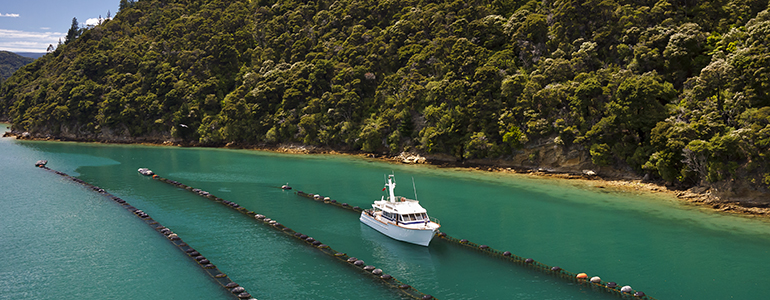Ahumoana | Aquaculture
On this page

© MarlboroughNZ
Marlborough produces about 50% of New Zealand’s exported aquaculture products, mostly mussels and salmon. Jobs in the sector are a mix of onshore processing and aquaculture.
The importance of the sector across Te Tauihu was identified in the Te Tauihu Intergenerational Strategy. Iwi across Te Tauihu are invested in marine farming and have identified the development of an Oceans Economy Strategy as a priority area for strengthening our regional economy. We are collaborating with the Nelson RSLG to take a Te Tauihu approach to the sector. This aligns with the Government’s strategy of growing the sector to $3 billion by 2025.
Employment in the sector is primarily located in Havelock, Blenheim and Picton. The sector is important in these parts of Marlborough as it provides employment where there may otherwise be limited job opportunities. The sector offers a mixture of seasonal work and full-time employment.
Challenges and opportunities
- The sector is a large regional employer, especially in Havelock
- There is significant local investment in the sector exemplified by the new processing and nutraceuticals plant
- The sector underpins our expert manufacturing/engineering sector especially in boat building and equipment
- There is an opportunity to engage with the expert manufacturing industry transformation plan as well as other government work related to the aquaculture strategy
- The sectors workforce is projected to double nationally
- As the sector changes, there will likely be an increase in specialist skills needed
- There is limited data about the number of people employed in the seafood sector and in what roles
- There is an ongoing labour and skills shortage across a variety of roles
- The number of people willing and able to work in the sector has been declining. Accommodation, transport and social isolation have been raised as barriers to recruitment. This is especially relevant for roles in Havelock which require private transport.
- Pay for aquaculture farming operations is comparatively low
- Working conditions are off-putting for some– it is often characterised by hard physical work, high risk environments and drug and alcohol testing
- The seasonal nature of some roles limits the opportunities for full-time, permanent roles
- There is limited local training and many roles have no opportunity to upskill
- Warming in the Marlborough Sounds will likely impact the ongoing nature of the sector locally.
Cross cutting challenges
- Recruitment difficulties due to perceptions of the industry
- Career pathways.
Immediate actions
- Support Aquaculture NZ to implement their draft workforce plan across Te Tauihu in collaboration with the Nelson Tasman RSLG and Muka Tangata and other government agencies including MPI and MSD. Actions are focused around, pathways and promotion, perceptions, projections, pastoral support, people progression, immediate shortfall (migrant labour) and investment in the system (transformation).
Progress to date
- Stakeholder engagement with Aquaculture NZ, Marine Farming Association and industry on the aquaculture workforce strategy.
Key regional facts
Filled jobs
1200 people
GDP
$106 million
Skills
Mix of semi-skilled, skilled and highly skilled roles
11% of shore-based processing requires a qualification
57% of aquaculture requires a qualification
Local training
NMIT (block course in Nelson)
Skipper’s tickets and Diving courses
Primary ITO
Migrant labour
Aquaculture: currently very low reliance on migrant labour.
On shore processing: increasing reliance, especially people on working holiday visas
Demographics
Nationally 65% male
Future growth
Workforce likely to double nationally but labour and skills implications not known
Relevant plans
The New Zealand Government Aquaculture Strategy to 2025 [PDF, 2.9MB](external link) — Ministry for Primary Industries

